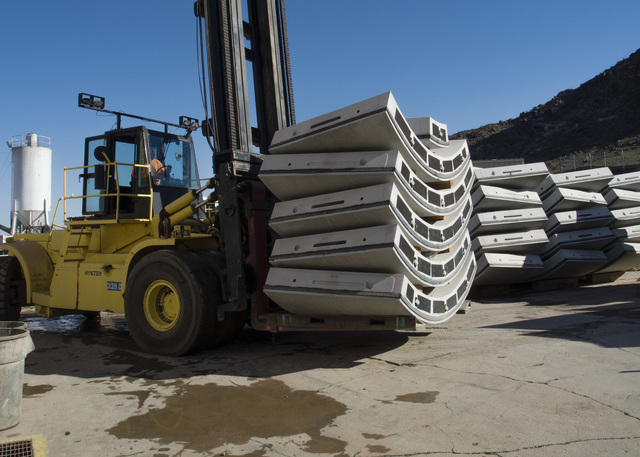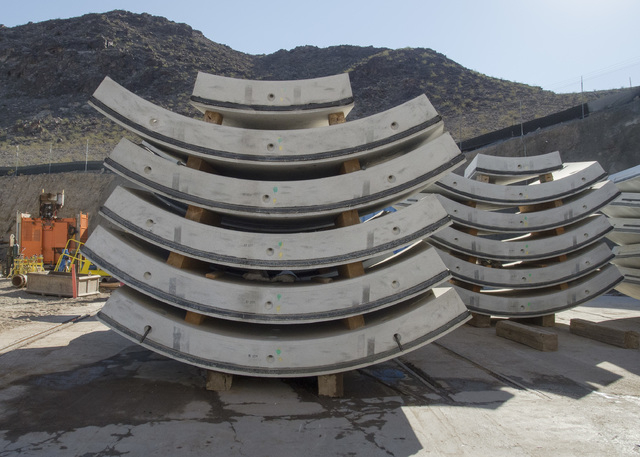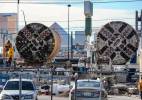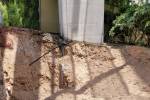After seven years of digging, Vegas reaches its last straw
After a road trip lasting almost three years, the Southern Nevada Water Authority is about to score the perfect parking spot for its custom ride.
Sometime today, the authority’s massive underground tunneling machine should break through a reinforced concrete wall at the bottom of Lake Mead, completing its three-mile journey to connect with a 100-foot-tall drain pipe that has been waiting at the bottom of the reservoir since 2012.
The machine was within about 3 feet of making the connection when mining stopped Tuesday afternoon.
“It looks like we’ll be hitting it,” said Erika Moonin, an engineer and manager for the water authority’s third intake project. “We’ll be gently hitting it.”
The news is likely to prompt cheers at the work site and relief from authority officials in Las Vegas.
“This is a big deal,” said Marc Jensen, the agency’s director of engineering. “It’s very exciting.”
The margin for error is no bigger than a newspaper page.
GETTING THERE
To connect the tunnel with the intake structure, workers from general contractor Vegas Tunnel Constructors had to guide the 1,500-ton machine along a sweeping arc through solid rock beneath the nation’s largest man-made lake and wind up within two feet of their intended target.
It’s not yet known exactly how close they are to hitting the bull’s-eye, but one independent review in October showed the machine within two inches of where it was supposed to be.
The machine has been kept on course using what Moonin called “traditional surveying methods,” albeit with the help of hi-tech lasers and optical devices.
“They didn’t use a hand-held level and a chain,” Jensen said.
Workers knew they were on the right track a few days ago when the machine began to chew through concrete that was poured on the lakebed in 2012 to secure the intake structure — basically a box topped with a stainless steel funnel, the whole thing 100 feet tall and weighing 1,200 tons.
By Tuesday, miners were closing in on what’s known as the “soft eye,” a portion of the intake’s concrete wall that is 18 inches thick and reinforced with fiberglass instead of steel to make it easier for the tunneling machine to cut through it.
Moonin said this is where precision is key since the machine is 23½ feet in diameter and the soft eye measures 25½ feet.
But accuracy isn’t the only source of anxiety for project officials.
Punching through to the intake structure represents one of the most dangerous moments for the workers underground because it will open what Jensen called “a direct connection to the lake.” Once that happens, the only thing separating those workers from roughly 3.4 trillion gallons of water will be the pressurized seal formed by the tunneling machine around them.
FAILURE NOT AN OPTION
Today’s breakthrough will mark the biggest milestone yet — and one of the last — for an $817 million project that ranks as the most complicated and expensive in the water authority’s history.
The new intake and tunnel are designed to keep water flowing to Las Vegas even if Lake Mead shrinks low enough to leave the community’s two existing straws high and dry. Such access is crucial for a community that relies on the lake for 90 percent of its water supply.
The water authority board is expected to vote today on whether to spend another $650 million on a new pumping station that would keep the third intake working even in the unlikely event that the reservoir shrinks too low for Hoover Dam to release water downstream.
It’s not hard to be impressed.
Gov. Brian Sandoval donned a hard hat and orange vest to tour the intake tunnel Friday, and he talked about what he saw during last weekend’s meeting of the Western Governors Association in Las Vegas.
“If you ever had any doubt in the capability (and) the ingenuity of modern engineering, you won’t have any doubt any more if you (go) down there,” said Sandoval as he opened the meeting Saturday. “... It really made an impression on me in terms of what has to be done and what is being done throughout the West to ensure a secure water supply in the future for Nevada.”
Work on the new intake began in 2008 with excavation of a 600-foot vertical access shaft on a peninsula on the west side of the lake. Since then, the project has been hit by a series of setbacks that added more than two years and almost $40 million to the cost.
The worst moment came on June 11, 2012, when a construction accident in the tunnel killed Thomas Albert Turner, 44. The underground miner and father of two is remembered around the job site with Superman stickers on hardhats and on some buildings.
Moonin said the project currently employs about 120 workers on three shifts. There is usually work going on 24 hours a day, six days a week.
Once the tunneling machine breaks through, it will push its way another 15 feet or so into the intake structure before stopping for good, Moonin said.
The metal shield at the front of the machine will become a permanent part of the third straw itself. First, though, a metal bulkhead will be lowered from a barge to cover the mouth of the intake, allowing it to be sealed and drained so workers can safely enter and secure the shield in place.
That will also give the miners a chance to celebrate their accomplishment in the traditional way. Jensen said it’s customary for workers on large tunneling projects to crawl out through their machine’s cutter head when the job is done. That’s not possible now because the cutter head is under water.
BACKING OUT
Moonin said it should take about two months to back the massive machine out of the new tunnel and hoist it in pieces to the surface, 600 feet above. She said some parts of the $25 million machine will be sent back to the factory in Germany where the giant rock-chewing worm was designed and built especially for this project.
After the tunnel has been cleared, workers will install pipes inside to collect water samples and feed in chemicals to keep invasive quagga mussels from colonizing the intake. The final step is removing the bulkhead to flood the tunnel, Moonin said.
If all goes according to plan, the third intake should begin delivering water to valley homes by summer.
Jensen said valley residents will never know the difference, though he joked that water taken from the bottom of the lake “might be a little colder.”
Review-Journal writer Laura Myers contributed to this report. Contact Henry Brean at hbrean@reviewjournal.com or 702-383-0350. Follow @RefriedBrean on Twitter.
The tunnel

Click for a larger view of the graphic
Dec. 13, 2009: The right machine for the job — A look at the overall project

May 17, 2012: Leaks slow construction, add $5 million to cost

Aug. 3, 2013: A tour of the tunnel project








































